Have you ever wondered if trees die of old age? Do they reach a point where they simply give up on life? The truth is, trees don’t die because of genetically programmed aging. Their lifespan is not limited by an intrinsic increase in mortality with age. Instead, trees typically meet their demise due to external agents or disturbance events.
Tree longevity is a fascinating subject that spans thousands of years. Understanding the factors that contribute to tree lifespan is crucial for conservation policies and management strategies. Let’s dive deeper into the mysteries of tree longevity and explore why trees don’t die of old age.
Key Takeaways:
- Trees do not die because of old age, but rather due to external agents or disturbance events.
- Tree longevity can span thousands of years and is not limited by age-dependent mortality.
- Various factors, such as wildfires, droughts, insect outbreaks, and human impacts, can cause tree mortality.
- Understanding tree lifespans is crucial for conservation policies and management strategies.
- Tree lifespan provides valuable insights into the history of environmental change and ecosystem resilience.
The Immortality of Trees: The Role of Cambium
Trees have long fascinated humanity with their majestic presence and longevity. While the concept of immortality may seem far-fetched in the realm of living organisms, the aging process of trees challenges our conventional understanding.
The growth tissue area between the bark and wood, known as the cambium, plays a crucial role in the immortality of trees. Unlike other cells in an organism, cambium cells appear immune to senescence, the process of aging and deterioration. This resilience suggests that trees, in theory, have the potential to live indefinitely.
Gene expression analyses have shed light on the intricate processes that maintain a delicate balance between growth and aging in old trees. Factors affecting tree lifespan include sustained growth over extended periods of time and the ability to increase growth rates when favorable conditions arise.
It is interesting to note that tree size, both in terms of girth and height, is not a reliable indicator of maximum lifespan. While giant ancient trees hold a certain allure, smaller and younger trees can also exhibit remarkable longevity.
In conclusion, the extraordinary lifespan of trees defies traditional notions of aging and immortality. The cambium, by preserving a perpetual youthfulness, holds the key to their enduring presence on our planet. Understanding the factors that influence tree lifespan is vital for effective forest management and conservation efforts.
External Forces: Causes of Tree Mortality
Tree mortality can be attributed to a variety of external forces that pose significant threats to tree health and survival. Understanding the signs of a dying tree and implementing proper management strategies are crucial for preventing or mitigating tree mortality.
Signs of a Dying Tree
When a tree is in poor health or nearing the end of its life, it may exhibit several signs indicating its imminent decline. These signs may include:
- Wilting leaves or branches
- Discoloration or yellowing of foliage
- Dead branches or excessive leaf loss
- Decay or rot in the trunk or major branches
These visible indicators can serve as warnings that a tree is experiencing significant stress or has succumbed to disease, insects, or other detrimental factors.
Causes of Tree Mortality
Tree mortality can be attributed to a range of external forces:
- Wildfires: Uncontrolled and severe wildfires can engulf vast forested areas, destroying trees and their habitats.
- Droughts: Prolonged periods of drought can deplete soil moisture, leading to water stress and eventual tree mortality.
- Insect Outbreaks: Infestations by harmful insects, such as bark beetles, can weaken trees and make them more susceptible to disease and death.
- Bacteria, Viruses, and Fungi: Pathogens can infect trees, causing disease and ultimately leading to their demise.
- Human Impacts: Activities such as deforestation, habitat destruction, pollution, and improper tree care practices can contribute to tree mortality.
These external forces can interact and compound one another, exacerbating the risk of tree mortality and posing significant challenges to tree health and ecosystem stability.
Maintaining Tree Health and Management Strategies
To safeguard trees and mitigate the risks of mortality, it is essential to prioritize tree health and implement effective management strategies:
1. Regular Tree Inspections: Conduct routine inspections to identify signs of stress, disease, or pests. Early detection allows for prompt treatment or intervention.
2. Proper Tree Care: Provide adequate nutrients, water, and regular pruning to promote tree vigor and resilience.
3. Pest and Disease Management: Implement integrated pest management strategies and employ appropriate pest and disease control measures when necessary.
4. Fire Prevention and Control: Practice responsible fire prevention measures, including controlled burns and fire breaks, to minimize the risk of devastating wildfires.
5. Conservation Efforts: Protect and conserve natural habitats, forests, and biodiversity to preserve the ecosystem services provided by trees. Support reforestation and afforestation initiatives to increase tree cover and combat deforestation.
6. Public Awareness and Education: Raise awareness about the importance of tree health, tree care practices, and the impact of human activities on tree mortality. Educate communities on the value of trees and their crucial role in environmental sustainability.
By prioritizing tree health and implementing appropriate management strategies, we can work towards reducing tree mortality and ensuring the long-term survival and vitality of our precious arboreal ecosystems.
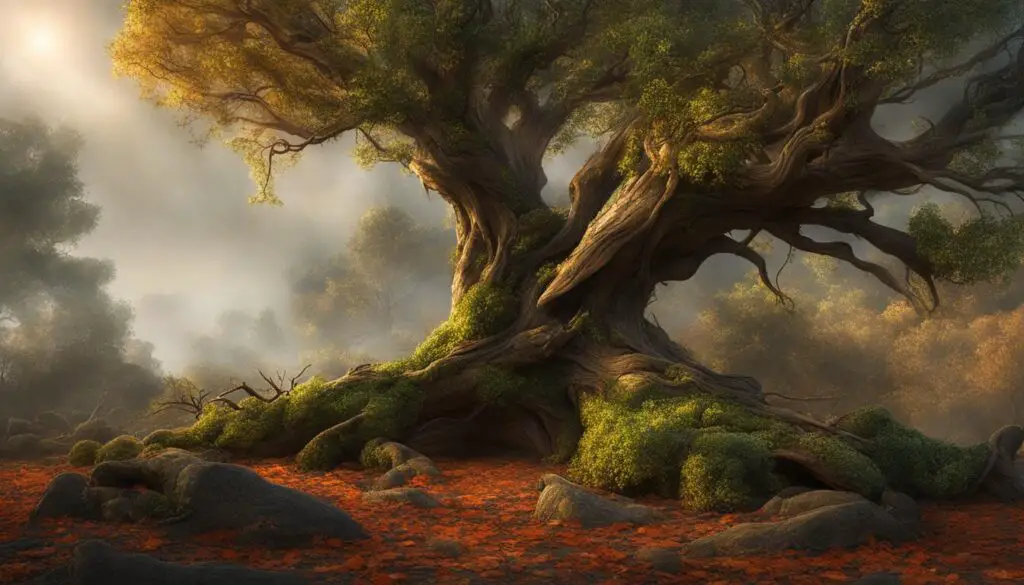
Natural Archives of Environmental Change
Trees play a vital role as natural archives of environmental change, providing us with significant insights into the history of our planet. They act as living records, documenting the long-term impacts of natural and human-induced factors on our ecosystems. Old-growth forests, home to ancient trees, are particularly valuable in studying environmental variability and sudden events that have shaped our world over time.
Unfortunately, the distribution of old-growth forests has been significantly reduced due to human activities. Their preservation and restoration are essential for accessing a comprehensive understanding of our past and informing sustainable management practices for the future.
Let’s take a closer look at the significance of tree longevity, the environmental changes they record, and the importance of old-growth forests in unraveling the complexities of our world.
Tree Longevity and Environmental Change
Tree longevity is a remarkable phenomenon that allows us to gain insights into the environmental conditions present during their long lifespan. The ability of trees to withstand both gradual climate shifts and sudden disturbances offers us a unique perspective on environmental change.
Through the study of tree rings, known as dendrochronology, researchers can decipher information about past climates, such as temperature and precipitation patterns. Each ring represents a year of growth and carries a wealth of data that can be analyzed to understand historical climatic events.
Old-growth forests, in particular, provide an invaluable window into the past. These ancient ecosystems harbor trees that have stood witness to centuries, enabling us to reconstruct historical landscapes and study the impacts of natural processes and human activities. By examining the growth patterns and chemical composition of tree rings, scientists can unveil details about past disturbances, such as fires, storms, and epidemics, and their consequences for forest dynamics.
The Value of Old-Growth Forests
Old-growth forests are more than just collections of ancient trees; they are dynamic ecosystems with immense ecological value. These forests serve as biodiversity hotspots, providing habitats for various species, some of which rely on old-growth conditions for survival.
Furthermore, old-growth forests offer unique opportunities for scientific research. They provide invaluable data on long-term ecological processes, including carbon storage, nutrient cycling, and species interactions. By studying these undisturbed ecosystems, we can gain deeper insights into the functioning of healthy forests and their resilience to environmental change.
| Key Contributions of Old-Growth Forests | Examples |
|---|---|
| Biodiversity conservation | Amazon rainforest |
| Carbon sequestration and storage | Tongass National Forest, Alaska |
| Climate regulation | Vancouver Island Coastal Douglas-fir ecosystem, British Columbia |
Protecting and restoring old-growth forests is crucial for the preservation of these vital ecosystems, as well as for gaining a deeper understanding of the far-reaching impacts of environmental change. By recognizing the value of old-growth forests and implementing sustainable forest management practices, we can ensure the long-term health and resilience of our ecosystems.
Longevity of Conifer Trees
Conifer trees, known for their majestic presence in forests, have fascinated scientists and nature enthusiasts for centuries. These ancient conifers have proven their resilience by exceeding incredible lifespans, often reaching over 2,000 years.
Among the conifer species that have stood the test of time are junipers, sequoias, cypresses, and pines. These remarkable trees have persevered through the ages, witnessing the ebb and flow of countless generations.
Some conifers have even been dendrochronologically tested, revealing ages surpassing 1,000 years. Species such as Agathis, Australian pine, and Douglas-fir bear testament to the longevity inherent in the conifer family.
Conifer tree lifespan is a result of their ability to resist or avoid mortality caused by external forces. These trees possess a remarkable capacity for sustained growth over extended periods, enabling them to withstand various environmental challenges.
To truly appreciate the magnitude of these ancient conifers, behold the serene beauty of a sequoia forest, where time seems to stand still. As you gaze at these towering giants, it becomes evident why they are nature’s living monuments.
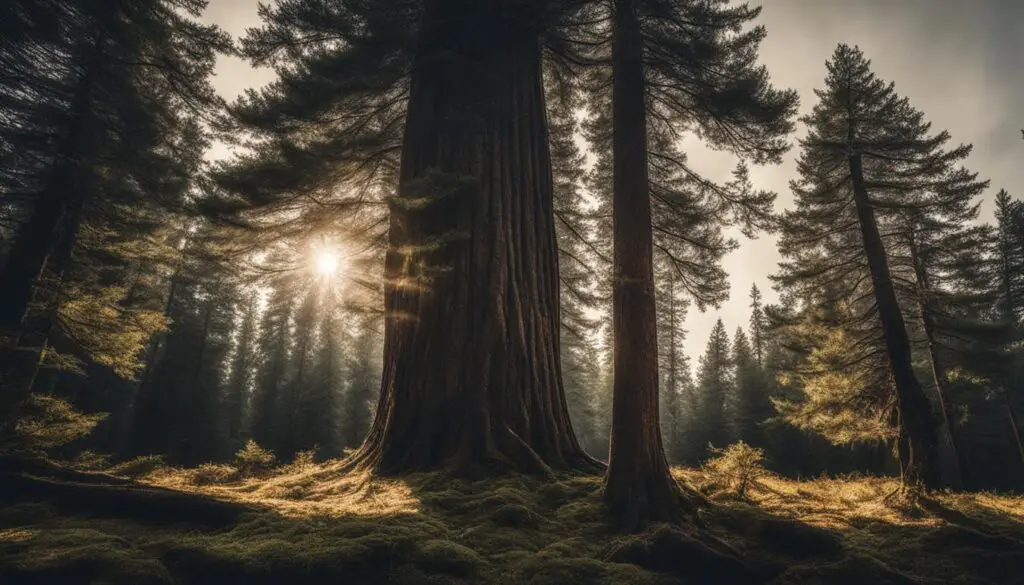
Through their resilience and longevity, conifer trees remind us of the profound connection between nature and time, offering a glimpse into the wisdom of the past and a promise for the future.
The Role of Fire in Forest Management
Fire plays a crucial role in the regeneration and management of forest ecosystems, particularly for certain tree species like sequoias. These majestic giants rely on fire to create favorable conditions for their own reproduction and to remove competition from other species.
Sequoias have adapted to withstand and even benefit from fire. Their thick, fire-resistant bark protects them during wildfires, allowing them to survive and continue growing. In fact, fire helps sequoias by clearing the forest floor of debris, increasing soil fertility, and creating open spaces for new sequoia seedlings to take root.
However, the suppression of fires in certain forest ecosystems can have negative consequences on tree health and overall forest management. Without the natural role of fire, other tree species that compete with sequoias may dominate the ecosystem, reducing the opportunities for sequoia regeneration and weakening the overall biodiversity. This highlights the importance of finding the right balance between fire management and forest conservation.
Forest managers now recognize the value of controlled burns as a management tool to mimic the natural role of fire. Controlled burns help reduce excessive fuel loads, prevent the buildup of flammable materials, and create the conditions necessary for sequoia regeneration and the preservation of forest health.
“Fire is a powerful tool that can be harnessed for the benefit of both the environment and human communities. By understanding the ecological role of fire, we can implement effective forest management practices that promote tree regeneration, biodiversity, and overall ecosystem health.”
By integrating fire management strategies into forest conservation plans, we can ensure the long-term survival of tree species like sequoias and the overall resilience of forest ecosystems.
To visualize the significance of fire in forest management, take a look at the table below that summarizes the key points:
| Role of Fire in Forest Management | Benefits | Consequences |
|---|---|---|
| Promotes tree regeneration | – Creates open spaces for seedling growth – Clears competition from other tree species |
– Excessive fire suppression can hinder regeneration and disrupt ecosystem balance |
| Clears forest floor debris | – Increases soil fertility – Reduces the risk of severe wildfires |
– Lack of fire can lead to the buildup of flammable materials |
| Preserves biodiversity | – Creates diverse habitats for plants and animals – Supports a healthy ecosystem |
– Dominance of competing tree species can reduce biodiversity |
As we can see, fire plays a critical role in forest management, and understanding its ecological significance is vital for effective conservation efforts.
Tree Longevity and Landscape Resilience
The Great Basin in Nevada is a remarkable example of landscape resilience and the endurance of ancient ecosystems for thousands of years. These landscapes provide tangible evidence that ecosystems have a remarkable capacity for resilience, even in the face of challenging conditions. They offer valuable insights into the longevity of trees and the critical role they play in preserving and restoring entire ecosystems.
To fully understand and appreciate the resilience of these landscapes, it is crucial to grasp the concept of tree longevity. Trees that have survived in the Great Basin for centuries or even millennia exemplify the extent to which nature can adapt and persist. Their extreme longevity challenges traditional notions of environmental limits and urges a reassessment of classic ecological theories.
Studying the ancient trees of the Great Basin can offer valuable insights into the environmental changes that have shaped our planet. By identifying and preserving these trees, scientists can unravel the intricacies of past climates and the effects of human activities on these delicate ecosystems. This knowledge is essential for developing effective conservation strategies and restoring ecosystems that have been perturbed by human impact.
Furthermore, the extremity of tree longevity in the Great Basin gives us a chance to reevaluate our understanding of landscape resilience. These ancient trees and their continuous existence offer hope that other ecosystems may possess hidden reservoirs of resilience, beyond what we currently comprehend. They inspire us to continue studying and conserving the natural world, respecting its remarkable ability to adapt and thrive.
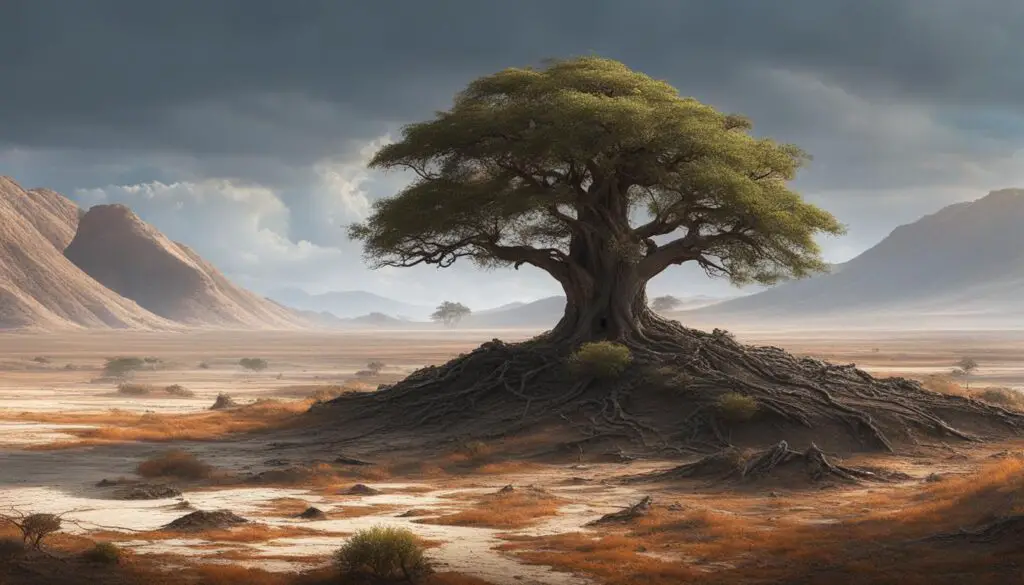
| Key Insights: |
|---|
| The Great Basin showcases landscapes with extreme resilience and ancient ecosystems that have persisted for thousands of years. |
| Understanding the longevity of trees in such landscapes is crucial for conserving and restoring entire ecosystems. |
| Identifying extremely old trees is essential for reevaluating classic ecological theories and improving our understanding of environmental change. |
Genetic Mechanisms of Longevity in Forest Trees
When it comes to the longevity of forest trees, genetic factors play a crucial role. Researchers have discovered specific gene families that are highly represented in long-lived tree species. These gene families are associated with immune defense and include RLK, RLP, NLR, and CC-NBS-LRR.
In addition to immune defense, other genes involved in DNA repair, defense response, and genome integrity have also been found to be associated with tree longevity. These genetic mechanisms help trees withstand external factors and maintain their vitality over an extended period.
Furthermore, epigenetic regulators and changes in gene expression can rejuvenate old trees and extend their lifespan. This process allows trees to adapt to changing environments and enhance their ability to survive.
The genetic mechanisms of longevity in forest trees provide valuable insights into their resilience and ability to thrive in various conditions. By understanding these mechanisms, scientists and conservationists can develop strategies to preserve and protect the lifespan of forest trees.
Longevity of Ficus Trees
Ficus trees, particularly Ficus benghalensis and Ficus religiosa, are known for their remarkable longevity. These species have the ability to live for several centuries, and in some cases, individual trees have reached ages of thousands of years. The impressive lifespan of Ficus trees is a testament to their resilience and adaptability in various environments.
The longevity of Ficus trees can be attributed to genetic mechanisms that enhance their immune defense. These trees possess genes associated with preformed and inducible defense mechanisms, allowing them to effectively combat diseases, pests, and other threats. By bolstering their immune systems, Ficus trees are able to withstand the test of time and thrive in diverse ecological conditions.
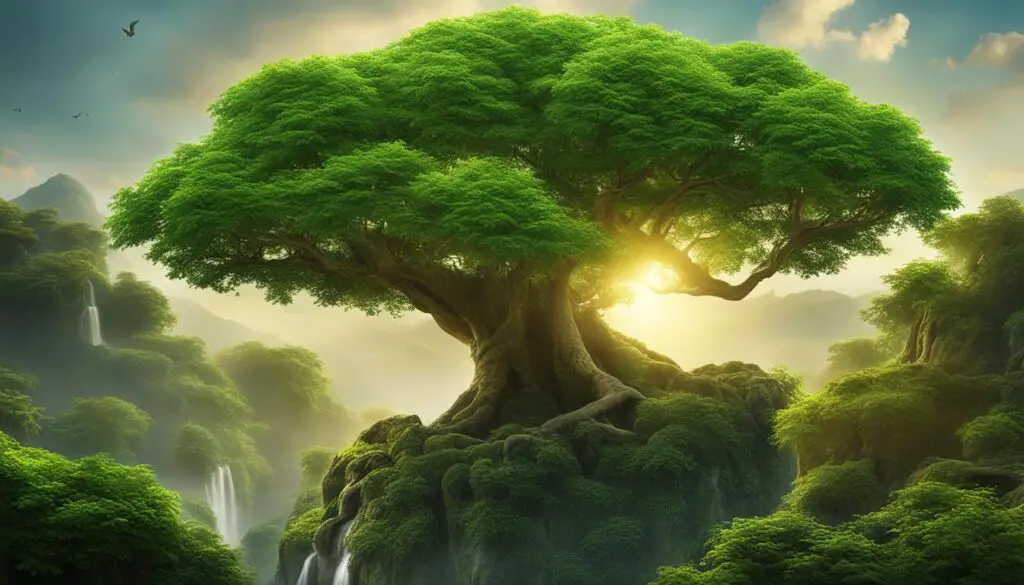
Patterns of Longevity in Forest Trees
When it comes to the lifespan of trees, there is remarkable variability within species. This variation is influenced by environmental gradients such as elevation and site fertility. In harsher environmental conditions, where resources may be limited, trees have adapted to promote longevity through reduced growth rates.
The relationship between growth rates and longevity holds true even within species growing along environmental gradients. This suggests that trees have the ability to adjust their growth patterns in response to environmental factors, ultimately impacting their lifespan.
In addition to growth rates, other life history traits, such as wood anatomy and mechanical properties, may also contribute to tree lifespan. Trees that possess specific adaptations to withstand environmental stressors are often able to live longer than their counterparts.
“Within-species variation in tree lifespan is a fascinating phenomenon, highlighting the adaptability and resilience of trees to their respective habitats.”
By studying these patterns of longevity, we gain valuable insights into the ways in which trees interact with their environment and navigate environmental challenges over the course of their lives.
| Environmental Factor | Effect on Tree Lifespan |
|---|---|
| Elevation | Higher elevation often correlates with harsher growing conditions, which can lead to increased tree lifespan. |
| Site Fertility | Less fertile sites may limit access to essential resources, resulting in slower growth rates and extended tree lifespan. |
Link Between Longevity and Climate
Climate plays a crucial role in controlling tree lifespan. The bioclimate factors of annual precipitation and temperature have a significant influence on the expression of maximum lifespan in different forest stands.
Harsher environmental conditions, such as lower annual precipitation and extreme temperatures, often result in increased tree longevity. Trees in arid regions or high-altitude areas have adapted to survive in these challenging conditions, leading to extended lifespans.
Understanding the link between climate and tree lifespan is essential for predicting the effects of climate change on forest ecosystems. As global temperatures and precipitation patterns continue to shift, it is crucial to assess how these changes will impact the longevity of tree species and the overall health of forest ecosystems.
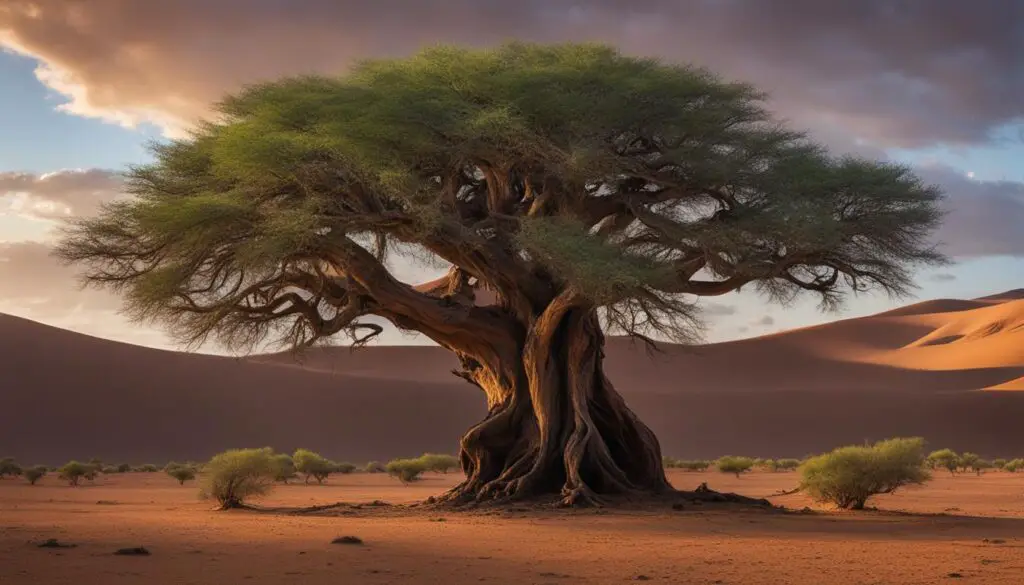
Bioclimate Factors Influencing Tree Lifespan
The bioclimate factors affecting tree lifespan include:
- Annual Precipitation: Trees in regions with higher annual precipitation tend to have shorter lifespans due to increased growth rates and a higher likelihood of exposure to fungal diseases.
- Temperature: Extreme temperatures can stress trees and decrease their lifespan. However, some tree species have evolved to withstand specific temperature ranges, enabling them to thrive in challenging environments.
Adaptation to Harsh Environmental Conditions
Trees that have adapted to harsh environmental conditions, such as arid climates or high elevations, often exhibit increased longevity. These trees have evolved mechanisms to conserve water, withstand temperature extremes, and fend off pathogens.
“In challenging environments, trees with the genetic traits for increased longevity have a competitive advantage and are more likely to survive and reproduce.”
The ability of trees to adapt and thrive in extreme conditions is a testament to their remarkable resilience. By studying these resilient tree species, scientists can gain insights into the genetic and physiological mechanisms that contribute to enhanced longevity.
Conclusion
Trees do not die of old age, but instead, their longevity is influenced by various genetic and environmental factors. While trees can live for thousands of years, they are often killed by external agents and disturbances such as wildfires, droughts, insect outbreaks, diseases, and human impacts. Understanding the lifespan of trees and the mechanisms that contribute to their longevity is crucial for effective forest management and conservation efforts.
Further research is needed to unravel the intricate genetic and ecological processes involved in tree lifespan. By protecting and studying old trees, we can gain invaluable insights into the history of environmental change and the resilience of ecosystems. Trees serve as natural archives, providing a long-term perspective on the impacts of both natural and human-driven events on our world.
Conservation policies and management strategies can be informed by a better understanding of tree lifespans. By implementing measures to maintain tree health and prevent or mitigate the causes of tree mortality, we can ensure the long-term survival of these essential organisms. Trees are not only vital for maintaining biodiversity, but they also play a critical role in regulating climate, providing habitat for countless species, and contributing to the overall well-being of our planet.
FAQ
Do trees die of old age?
No, trees do not die because of genetically programmed age deterioration. Instead, they are typically killed by external agents or disturbance events.
What are the causes of tree mortality?
Tree mortality can be caused by various external forces, including wildfires, droughts, insect outbreaks, bacteria, viruses, fungi, and human impacts.
What are the signs of a dying tree?
Signs of a dying tree may include wilting, discoloration, dead branches, and decay.
What is the role of cambium in tree lifespan?
The growth tissue area between the bark and the wood, known as the cambium, appears immune to senescence, suggesting that trees could potentially live indefinitely.
What factors affect tree lifespan?
Factors affecting tree lifespan include sustained growth over extended periods of time and the capacity to increase growth rates when favorable conditions arise.
How do conifer trees demonstrate longevity?
Some conifer tree species, such as juniper, sequoia, cypress, and pine, have demonstrated the capacity to exceed 2,000 years of age by resisting or avoiding mortality from external forces and sustaining growth over extended periods.
What is the role of fire in forest management?
Fire plays a crucial role in the regeneration of certain tree species, such as sequoias, by removing competition and creating favorable conditions for their reproduction. However, finding the right balance between fire management and forest conservation is essential for the long-term survival of tree species.
How do old trees contribute to our understanding of environmental change?
Old trees serve as natural archives of environmental change, providing insights into the history of natural and human impacts on our world. They are particularly valuable in studying environmental variability and abrupt events in old-growth forests.
What are the genetic mechanisms of tree longevity?
Certain gene families associated with immune defense, DNA repair, defense response, and genome integrity have been found to be associated with tree longevity. Epigenetic regulators and changes in gene expression can also rejuvenate old trees and extend their lifespan.
How long can Ficus trees live?
Ficus trees, particularly Ficus benghalensis and Ficus religiosa, can live for several centuries, with some individual trees reaching ages of thousands of years. Their genetic mechanisms of longevity include enhanced immune defense and the expression of genes associated with defense mechanisms.
What patterns of tree lifespan exist within species?
There is significant within-species variation in tree lifespan, influenced by environmental gradients such as elevation and site fertility. Harsher environmental conditions often promote tree longevity through reduced growth rates.
How does climate affect tree lifespan?
Climate, including factors like annual precipitation and temperature, plays a crucial role in controlling tree lifespan. Harsher environmental conditions and lower growth rates often result in increased tree longevity.
What is a summary of tree lifespan insights?
Trees do not die of old age but rather due to external factors and disturbances. The longevity of trees is determined by various genetic and environmental factors. Understanding tree lifespans and the mechanisms that contribute to their longevity is essential for effective forest management and conservation.

